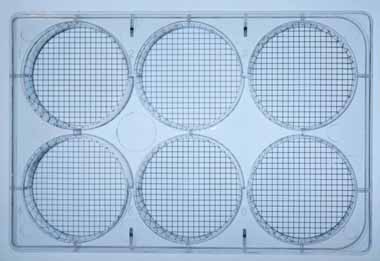Multiwell plates are one of the most commonly used tools in life science basic research as well as drug discovery area. It is as common in academic research labs as they are in biotech and pharmaceutical industry. Over the last decades, since its introduction, it has evolved into different formats, functionalities, and density of wells in the plates. Some of the next generation multiwell plates do not even look like standard multiwell plates.
Even today the most common format for a multiwell plate is 96 wells organized as 12 rows and 8 columns. There are multiwell plates available from 6, 12, 24, 48 wells besides 96 well format. The need for larger throughput in the drug discovery market made it necessary to develop higher density multiwell plates such as 384, 1536, and 3456 well plates. Multiwell plates are available in a dizzying array of choices, polystyrene, polypropylene, clear, white, black, V bottom, flat bottom, U bottom, opaque bottom, glass bottom, gridded bottom ( www.pioneerscientific.com)etc. The global market for the multiwell plates is estimated to be about 500 million dollars and this space is dominated by companies such as, Corning, BD, NUNC, and Greiner Bio-One.
Multiwell plate usage was driven initially by applications in serology, virology and immunology for performing serial dilutions. In the seventies, enzyme-linked immunosorbent assays (ELISA) made the use of the microwell plates very popular in clinical and research market. Later in the 80s and 90s high throughput screen (HTS) in the drug discovery market further fueled the growth of multiwell plate with higher density format plates. Originally designed for doing biochemical assays, multiwell plates are routinely used in biochemical, and cell based assays. For optimum attachment of cells to these plates, several manufacturers offer plates coated with extra cellular matrix (ECM) protein such as collagen, laminin, fibronectin, Poly-D Lysine etc. Besides the plates, the labeling and detection methods also have evolved from simple colorimetric readouts to highly sensitive fluorescent assays.
Peripherals
Major effort has also gone into two other areas which led to the popularity of the multiwell plates include the availability of multiwell diverse plate readers and liquid handling instruments. Varying options offered in these two areas has enabled customers to use the multiwell plates in a wide variety of applications, including single end point assays to multiplexing, and kinetic assays. Micro plate readers range from simple colorimetric readers to multimode readers capable of performing absorbance, luminescence, and fluorescence detection. Plate reader market is estimated to be 300 million dollars and the major instrument companies in this area includes, PerkinElmer Inc, ThermoFisher Scientific, and Tecan. Liquid handling instrument companies also offer a wide variety of choices to accommodate specific needs of the assays. Liquid handling instruments range their ability to dispense 100s of micro liters of reagents t into large well plates, to sub micro liter volume into the high density assay multiwell plates. Although small volume dispensed into the plates requires careful control of the temperature and humidity of the surroundings to prevent evaporation of the samples. Leading companies offering liquid handling instrumentation are Tecan, Caliper Life Sciences, Beckman Coulter, Eppendorf, and PerkinElmer.
Future Direction
During the last few years multiwell plate has evolved into different formats based on the functionality. In the genomic area multiwell plates has evolved into high density arrays either in a slide format or arrays printed inside a microwell plates. Affimetrix, a leader in the micro array technology offers its Gene Chip products which helps researchers to scan and identify the presence of particular gene, or expression levels of a biomarker in biological samples. Another development is the lab- on-a- chip systems where a series of micro fluidic channels direct the flow of reagents to immobilized antibodies, DNA or cells all integrated into a chip. Caliper Life Science is one of the leading companies in this area offering their LabChip system which can be used for immune assays, PCR assays and cell based assays. Label free detection is another promising technology gaining acceptance and momentum in the drug discovery market. Two companies in this field are Corning and SRU Biosystems. Corning (Epic System), and SRU Biosystems (BIND systems) offers high-throughput label free screening platform based on optical biosensor technology. These are multiwell plates with optical biosensors attached to the bottom of the plates. This system can be used for both biochemical and cell based assays in the multiwell format.
Availability of wide array of multiwell plates, plate readers, and liquid handling technology has accelerated the pace of basic research and drug discovery efforts. Although alternate methods and technology evolves from time to time to replace or compliment the multiwell plates, the popularity of multiwell plate will continue for the foreseeable future.

